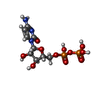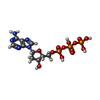+Search query
-Structure paper
| Title | Effects of chameleon dispense-to-plunge speed on particle concentration, complex formation, and final resolution: A case study using the Neisseria gonorrhoeae ribonucleotide reductase inactive complex. |
|---|---|
| Journal, issue, pages | J Struct Biol, Vol. 214, Issue 1, Page 107825, Year 2022 |
| Publish date | Dec 11, 2021 |
 Authors Authors | Talya S Levitz / Edward J Brignole / Ivan Fong / Michele C Darrow / Catherine L Drennan /   |
| PubMed Abstract | Ribonucleotide reductase (RNR) is an essential enzyme that converts ribonucleotides to deoxyribonucleotides and is a promising antibiotic target, but few RNRs have been structurally characterized. We ...Ribonucleotide reductase (RNR) is an essential enzyme that converts ribonucleotides to deoxyribonucleotides and is a promising antibiotic target, but few RNRs have been structurally characterized. We present the use of the chameleon, a commercially-available piezoelectric cryogenic electron microscopy plunger, to address complex denaturation in the Neisseria gonorrhoeae class Ia RNR. Here, we characterize the extent of denaturation of the ring-shaped complex following grid preparation using a traditional plunger and using a chameleon with varying dispense-to-plunge times. We also characterize how dispense-to-plunge time influences the amount of protein sample required for grid preparation and preferred orientation of the sample. We demonstrate that the fastest dispense-to-plunge time of 54 ms is sufficient for generation of a data set that produces a high quality structure, and that a traditional plunging technique or slow chameleon dispense-to-plunge times generate data sets limited in resolution by complex denaturation. The 4.3 Å resolution structure of Neisseria gonorrhoeae class Ia RNR in the inactive α4β4 oligomeric state solved using the chameleon with a fast dispense-to-plunge time yields molecular information regarding similarities and differences to the well studied Escherichia coli class Ia RNR α4β4 ring. |
 External links External links |  J Struct Biol / J Struct Biol /  PubMed:34906669 / PubMed:34906669 /  PubMed Central PubMed Central |
| Methods | EM (single particle) |
| Resolution | 4.3 Å |
| Structure data | EMDB-23773, PDB-7mdi: |
| Chemicals |  ChemComp-CDP:  ChemComp-DTP:  ChemComp-MG:  ChemComp-FEO:  ChemComp-HOH: |
| Source |
|
 Keywords Keywords |  OXIDOREDUCTASE / OXIDOREDUCTASE /  inactive complex / inactive complex /  ribonucleotide reductase ribonucleotide reductase |
 Movie
Movie Controller
Controller Structure viewers
Structure viewers About Yorodumi Papers
About Yorodumi Papers






